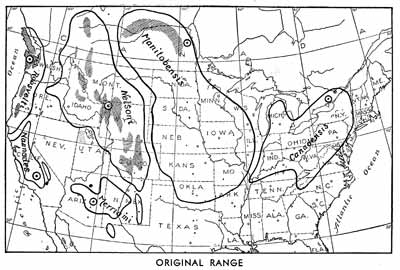By VERNON BAILEY
Page 1 [1] | Page 2 [2] | Page 3 [3] | Page 4

Subspecies of North American Elk
There seems to be no question as to the continuity of the original range of all of the North American varieties of elk, although the Roosevelt, Merriam and dwarf elk may have met other forms only in migration. The differences are slight and of a superficial nature, such as are generally shown by a wide ranging and plastic species, adjusting itself through a long period to varied environmental influences. It is noteworthy that the few recognized forms of North American elk fit into geographic areas of well marked climatic differences that are clearly reflected in the characters distinguishing the forms. Possibly other variations might have been recognized from Kentucky and Oklahoma if specimens had been saved 100 years ago from these areas, but it is now too late and the safest method seems to be to include these areas under the forms associated with similar types of country.
The following brief key to the six recognized forms or subspecies of North American elk is necessary for the better under-standing of the accompanying map. The relationship with Old World species and subspecies must be left for a complete study of this great holarctic group.
Canadian Elk or Wapiti
Cervus canadensis canadensis Erxleben, 1776.
Type locality, near Montreal, Canada.
Apparently not so large as the Rocky Mountain and Olympic forms, but as shown and described by Audubon and Bachman from eastern Pennsylvania animals, brighter brown And more richly colored than any of the western forms.
Became extinct about 1867.
Manitoba Elk or Wapiti
Cervus canadensis manitobensis Millais, 1915.
Type locality: Manitoba and eastern Saskatchewan.
Apparently larger and duller colored than typical canadensis; not so large or light colored as nelsoni of the Rocky Mountains. In summer rich chestnut brown, darker on head and neck and belly; in winter somewhat lighter.
A few thousand remain in good condition in western Manitoba and eastern Saskatchewan.
Rocky Mountain Elk or Wapiti
Cervus canadensis nelsoni Bailey, 1935.
Type from Yellowstone National Park. Sent alive to National Zoological Park from Gardiner, Montana, in 1904.
Size very large, antlers long and generally slender. Color in summer yellowish buff over body; head, neck and belly brown; in winter body buffy gray; head, neck, belly and legs brown.
Still abundant locally over a wide range in the Rocky Mountains. Introduced in many states, mainly in the West.
Roosevelt Elk or Wapiti
Cervus canadensis roosevelti Merriam, 1897.
Type from Mount Elaine, Olympic Mountains, Washington.
Size very large, apparently the largest of all the elk; antlers thick and often flattened or cupped toward the ends. Color in summer, body rich cinnamon buff ; head, neck and belly dark brown with much black, in winter body dark gray with dusky dorsal stripe and dusky on face and mane and belly.
Still a few thousand in the Olympic Mountains and Vancouver Island, and a few hundred in western Oregon and northwestern California.
The name Cervus occidentalis, (Hamilton Smith) is not considered tenable for any American elk.
Merriam Elk or Wapiti
Cervus canadensis merriami Nelson, 1902.
Type from head of Black River, White Mountains, Arizona.
Size about the same as the Rocky Mountain elk, skull massive; antlers long and heavy; color In summer, body yellowish brown; head and neck and belly dark brown; in winter body pale yellowish brown; head and neck and belly seal brown.
Became extinct about 1900.
Dwarf Elk or Wapiti
Cervus canadensis nannodes Merriam, 1905.
Type from Button Willow, Kern County, California.
Size smallest of the North American elk; antlers light and simple. Color in winter, body pale creamy buff; rump patch almost white; head and neck light brown; belly and legs tawny or pale cinnamon. Summer pelage not seen.
A few still remain on the Button Willow Ranch, and about 54 have been removed to Owens Valley, where 9 calves were reported in June, 1933.
